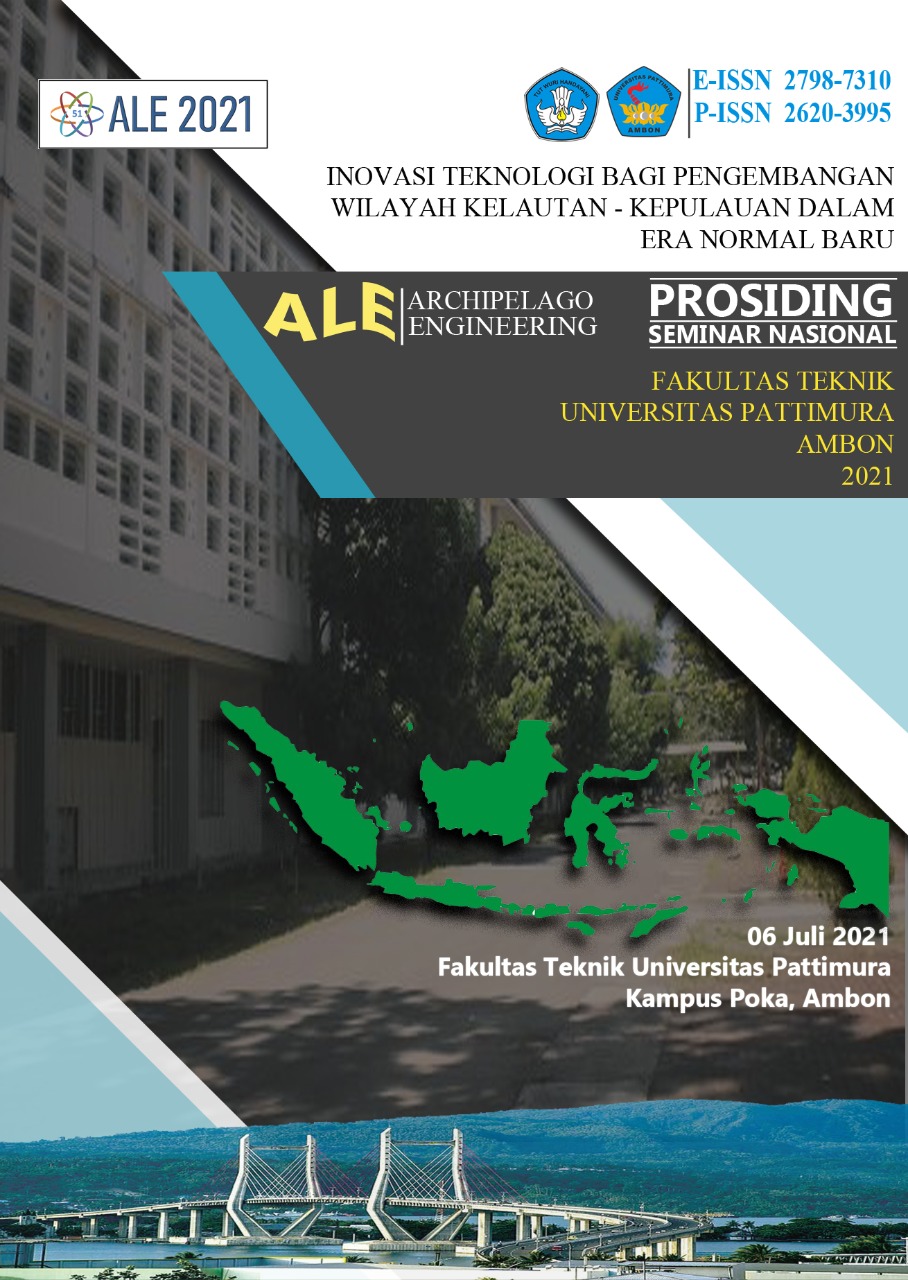MODEL STUKTURAL BERBASIS SISTIM INFORMASI GEOGRAFIS DALAM PENGELOLAAN WILAYAH PESISIR SECARA BERKELANJUTAN
Abstract
Geographical Information System-Based Structural Model in Sustainable Management of Coastal Areas which is the background is that the management of the coastal areas of Ambon City and Central Maluku Regency in the last 10-20 years has not been managed properly and sustainably so that various aspects of development do not work well causing various The problems include damage to the coastal physical environment, namely abrasion, erosion, and sedimentation, water damage due to pollution, damage to protective building infrastructure, coastal mitigation issues, declining quality of coastal environmental resources due to the increasing number of residents in coastal areas, causing the development of slum areas. coastal ecosystem. The purpose of the study is to determine the model and strategy for managing coastal areas in Ambon City and Central Maluku District in a sustainable manner. The method used in this research is the descriptive method. Primary data collection was carried out using a questionnaire for respondents from the community, expert respondents, community institutions, and policymakers. The analysis carried out is Sustainability Analysis with Multi Dimension Scale (MDS), geographic information system analysis, SEM structural analysis, Process Hierarchy analysis (AHP). The results of the sustainability analysis with MDS obtained the Multi-Dimensional Sustainability Index value of 50.13% is in the moderately sustainable category. The results of the SEM model analysis on the role of zoning and community roles in sustainable coastal area management is an acceptable “fit modelâ€. The results of the AHP provide an overview of the assessment by policymakers in the implementation of the program, prioritizing the strategy for Management of Sustainable Coastal Area Management Based on Geographic Information Systems with an assessment score of 39.3%, with the largest presentation being “Coastal Area Arrangement in accordance with GIS-Based Zoning Laws†of 13, 6%.
Downloads
References
[2] P. Berhitu (2007). Studi Kerusakan Garis Pantai Teluk Ambon Luar Dan Pengaruhnya Terhadap Tata Ruang Wilayah Kota Ambon. Prosiding Seminar Nasional Teknologi Kelautan. ITS . 243-249
[3] S. Helvina (2014). Pengaruh Deposional Terhadap Daya Dukung Lingkungan Perairan Teluk Ambon Bagian Dalam Untuk Pengembangan Keramba Jaring. Tesis S2 (tidak dipublikasikan). Program Pasca Sarjana Ilmu Lingkungan
[4] H. Lekatompessy, M. Djafar Saidi, dan A Tuwo (2012). Tanggung Jawab Pemerintah Kota Ambon Dalam Menangani Pemukiman Yang Berdampak Terhadap Lingkungan Pesisir Lateri Ambon. Jurnal Managemen Lingkungan 12 (2) 1-14
[5] F. Leuwol (2007). Pengaruh Sedimen Sungai Galala Terhadap Garis pantai Di Perairan Teluk Ambon. Tesis S2 (tidak dipublikasikan) Program Pasca Sarjana Universitas Gaja Mada
[6] S. Tuhumury, Uneputty, P. A dan Tupan, Ch. I. (2008). Sedimentasi dan Ekosistem Mangrove di sungai wairekang, Lateri Ambon. J. Ichthyos, 8 (2) : 87- 94
[7] T. J. Kakisina, (2009). Estimasi Efektifitas Penggunaan Groin Untuk Mengatasi Erosi Pada Kawasan Pesisir Pantai Utara Teluk Baguala Ambon. Jurnal Teknologi. 6 (2) 703-707
[8] J. Abrahamsz, dan M.A Tuapatinaja, (2005). Evaluasi Kawasan Konservasi Hutan Mangrove di Desa Passo. Jurnal Ichtyos, 4 (2): 93-98
[9] D. A. J. Selanno, A. S Julian, dan P. Beruat, (2008). Analisis Tingkat Kerusakan Mangrove di teluk Ambon Dalam. Jurnal Penelitian Perikanan, 8(1): 23-2
[10] A. J. Debby, E. M. Adiwilaga, R. Dahuri, M. Ismudi, dan H. Effendi (2009). Sebaran Spasial Luasan Area Tercemar dan Analisis Beban Pencemaran Bahan Organik Pada Perairan Teluk Ambon Dalam. Jurnal Torani 19 (2): 96 – 106
[11] D. A. Sihasale (2013). Keanekaragaman Hayati Di Kawasan Pantai Kota Ambon Dan Konsekuensi Untuk Pengembangan Pariwisata Pesisir. Journal of Indonesian Tourism and Development Studies, 1(1) 20 - 27
[12] P. Berhitu, dan Y. Matakupan (2010). Kajian Kelayakan Pengembangan Kawasan Pesisir Kota Ambon Sebagai Kota Pantai, Jurnal Teknologi dan Sains, 7(1):767-781
[13] I. Idris (2010). Penataan kelembagaan dalam pengelolaan sumberdaya pesisir dan kelautan: studi kasus di Teluk Ambon dalam, Kotamadya Daerah Tingkat II Ambon, Tesis Sekolah Pasca Sarjana Universitas Indonesia, 78-81
[14] P. Berhitu, W. Latuny dan M. Efruan. (2010). Preliminary Feasibility Study And Development Coastal Region of Ambon City as Ambon Water Front City in Supporting Potentials and Regional Competitiveness. Proceding International Conference on Marine Technology, Bangladesh Dacha, 67-72
[15] A. Yulia (2008). Pengaruh Pemanfaatan Lahan Terhadap Ekosistem Pesisir Dikawasan Teluk Ambon, Jurnal Wilayah dan Kota 12:15-25
[16] Badan Perencanaan Pembangunan Kota (Bappekot) Ambon Kota Ambon (2019). RTRW Kota Ambon (20013-2031). Penerbit Bappekot Ambon
[17] Badan Perencanaan Pembangunan Kabupaten Maluku Tengah 2008 - 2028 , Rencana Strategis Maluku Tengah 2018
[18] Badan Perencanaan Pembangunan Kota (Bappekot) Ambon Kota Ambon (2012). Rencana Strategis Kota Ambon 2012 - 2032
[19] Ditjen KP3K. (2019). Pedoman Penyusunan Rencana Zonasi Kawasan Pesisir dan Laut. Edisi ke II. Departemen Kelautan dan Perikanan.
[20] Dulbahri (2001). Sistem Informasi Geografis. Penginderaan Jauh Untuk Sumberdaya dengan Pendekatan Intepretasi Citra dan Survei Terpadu, Universitas Gadjah Mada Fakultas Geografi (PUSPICS) UGM-Bakorsutanal, Yogyakarta.
[21] ESRI, (1999). GIS for School and Libraries Version 5, Environmental Research Institute
[22] P. Kavanagh (2001). Rapid Appraisal of Fisheries (Rapfish) Project. Rapfish Software Description (for Microsoft Exel). University of British Columbia.
[23] P. Kavanagh, dan T. J. Pitcher (2004). Implementing Microsoft Excel Software for RAPFISH: A Technique for The Rapid Appraisal of Fisheries Status. The Fisheries Centre, University of British Columbia, 2259 Lower Mall Vancouver, Canada, V6T IZ4
[24] Wijaya dan Mustafa (2012). Panduan Teknik Statistik SEM Dan PLS Dengan SPSS AMOS. Konsep dasar SEM dan PLS: Pengenalan Amos dan
[25] F. Rangkuti (2009). Analisis SWOT Teknik Membelah Kasus Bisnis, Reorentasi Konsep Perencanaan Strategis Untuk Menghadapi Abad 2001. PT Gramedia Pustaka Utama Jakarta 188 hlm.
Copyright (c) 2021 Pieter Th. Berhitu

This work is licensed under a Creative Commons Attribution-ShareAlike 4.0 International License.
An author who publishes in the ALE Proceeding agrees to the following terms:
- Author retains the copyright and grants ALE Proceeding the right of first publication of the work simultaneously licensed under the Creative Commons Attribution-ShareAlike 4.0 License that allows others to share the work with an acknowledgment of the work's authorship and initial publication in this journal.
- Author is able to enter into separate, additional contractual arrangements for the non-exclusive distribution of the journal's published version of the work (e.g., post it to an institutional repository or publish it in a book) with the acknowledgment of its initial publication in this journal.
- Author is permitted and encouraged to post his/her work online (e.g., in institutional repositories or on their website) prior to and during the submission process, as it can lead to productive exchanges, as well as earlier and greater citation of the published work (See The Effect of Open Access).
Read more about the Creative Commons Attribution-ShareAlike 4.0 Licence here: https://creativecommons.org/licenses/by-sa/4.0/.






